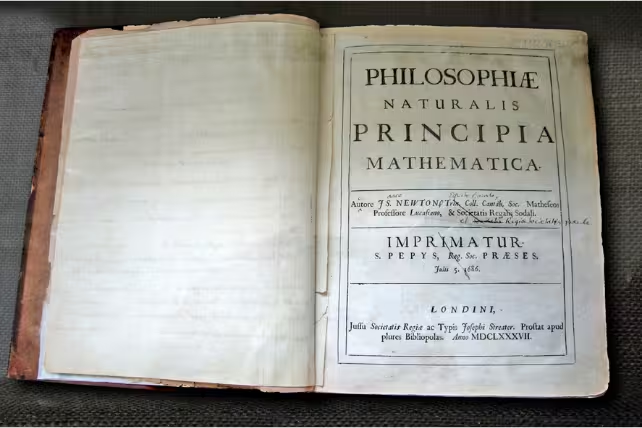5 Minutes
Re-examining the Foundations of Physics: Newton's First Law Under the Microscope
Sir Isaac Newton's laws of motion, first published in his 1687 masterwork "Philosophiæ Naturalis Principia Mathematica," form the bedrock of classical physics—and by extension, of our understanding of the universe's physical behavior. For more than three centuries, these principles have shaped teaching, research, and technological advancement in the fields of science and engineering. Yet recent scholarship reveals we might have been misinterpreting Newton’s very first law, the Law of Inertia, due to a subtle mistranslation dating back nearly 300 years.
The Original Text and Its Enduring Influence
Newton originally composed his revolutionary treatise in Latin, the scientific lingua franca of the 17th century, outlining three laws governing how objects move under the influence of forces. These laws, especially the first—commonly paraphrased as "an object at rest remains at rest, and an object in motion remains in motion in a straight line unless acted upon by an external force"—have been repeatedly translated, interpreted, and cited across generations.
However, in the widely referenced 1729 English translation, a crucial Latin word, "quatenus," was rendered as "unless," introducing nuanced but pivotal differences in philosophical and scientific meaning. This translation cemented a narrative where the first law seems to describe a world—one without any forces, where objects could theoretically travel forever in perfect straight lines.

Daniel Hoek's Investigation: A Closer Look at Newton’s Intent
Philosopher of science Daniel Hoek (Virginia Tech) revisited Newton’s Latin manuscripts, spurred by earlier linguistic observations published in 1999. Hoek’s scholarship suggests that the proper translation for "quatenus" is "insofar as," not "unless." This seemingly small distinction profoundly changes the primary message of Newton's first law.
Instead of merely positing how motion persists in the absence of forces—a scenario never realized in our universe—Newton’s original statement, as Hoek argues, demonstrates that every real-world change in motion (whether it is a start, stop, swerve, or spin) is necessarily the result of an external force. Hoek encapsulated this perspective, saying, “By restoring that one forgotten word, we restore one of the most fundamental principles of physics to its original brilliance.” His insight, formally published in 2022, highlights the crucial importance of linguistic precision in scientific thought.
The Broader Significance: Universal Laws in a Force-filled Cosmos
Hoek’s argument raises key questions: Why would Newton frame a foundational law around a world devoid of forces—when gravity, friction, and other influences permeate every aspect of existence? Noted Newton scholar George Smith (Tufts University) reinforces this view, telling Scientific American that Newton’s first law is designed to reveal the presence and effects of forces, not to describe some idealized state with none at work.
Newton himself provided vivid practical examples to clarify his first law. He discussed a spinning top, which naturally slows and veers in response to air friction—a real example of a body whose motion is always modified by external influences. As Hoek emphasizes, this demonstrates that Newton meant his law to have direct application to the physical world as we experience it, not just a hypothetical vacuum.

Expert Reflections and the Physics Community’s Response
As might be expected for a field so governed by tradition, Hoek’s reinterpretation has met mixed reactions within the academic community. Some consider the new translation so self-evidently correct as to require little debate, while others find the claim unconventional. Even so, physicists and philosophers largely agree that the real-world implications of Newton’s law remain unchanged—physical observations, engineering principles, and experimental results are consistent regardless of translation. Yet, from a scientific communication perspective, properly understanding Newton’s precise intentions lends clarity to students, educators, and researchers questioning the purpose and scope of the foundational laws of physics.
Relevance Beyond Earth: Universal Application From Atoms to Galaxies
The revolutionary aspect of Newton’s framework lay in its assertion that the cosmos—planets, stars, moons, and galaxies—obeyed the same laws as terrestrial objects. By emphasizing that every change in motion must be the result of external forces, Newton established a unifying principle: from the tumbling of atoms to the majestic spin of galaxies, the universe is bound by a consistent set of natural laws.
As Hoek reflects, this insight brings humanity full circle, reminding us of our connection to the farthest reaches of space. Every shift in speed or direction, no matter how distant or minute, is governed by the same timeless rules Newton articulated centuries ago.
Conclusion
Newton’s first law is far more than a historical footnote; it is a living principle that continues to shape scientific discovery and space exploration. The revelation that we may have misread its original intent for centuries highlights the profound influence of language in science and the importance of returning to primary sources. Understanding Newton’s true vision not only enriches our appreciation for the unity of physical laws but also deepens our sense of connection with the cosmos—a universe where, indeed, every motion tells the story of forces at work.
Source: doi



Comments